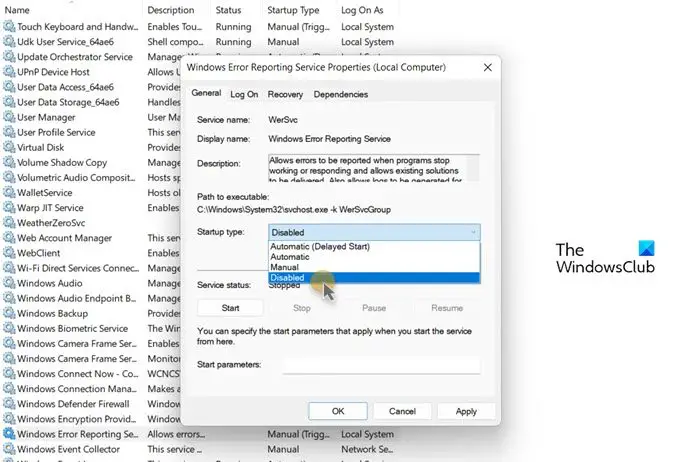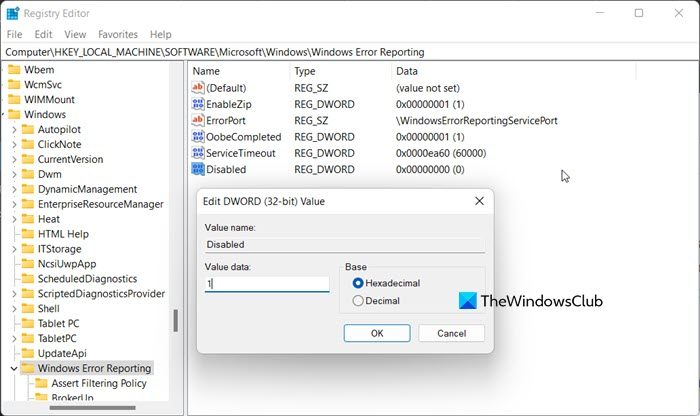The Windows Error Reporting feature in Windows 11/10 collects the error date and sends it to Microsoft. However, some users do not want Microsoft to collect their data. Microsoft’s developers are well aware of this and have included options to disable Error Reporting in Windows 11/10 using Services Manager, GPEDIT, and REGEDIT.

What is Windows Error Reporting?
Windows Error Reporting Service debuted with Microsoft Windows XP quite a long time ago. It looks after crashes and system failures and creates an error log file on your computer if something like this happens. It also sends information about crashes to Microsoft for further analysis. This information is then used to customize Windows and get rid of this issue.
This obviously raised many eyebrows as they ask users to send their data to Microsoft. Microsoft is not oblivious to these reports, which is why they have included options for the user to disable the Error Reporting feature.
Disable Error Reporting in Windows 11/10 using Services Manager, GPEDIT, REGEDIT
To disable Disable Error Reporting in Windows 11/10, we will use the following methods.
- Using Services Manager
- Using Regedit or Registry Editor
- Using Gpedit or Group Policy Editor
Let us start with the first method.
1] Using Services Manager

Services Manager or the Services app is the default software on your computer that can be used to manage many different settings. Many apps that you install or features that are already installed have a service that runs when you open them. To turn off Error Reporting, we will be using this same application. Follow the prescribed steps to do the same.
- Open Services Manager on your computer by searching “Services” in Start Menu’s Search field and opening the required app.
- Then, look for Windows Error Reporting Service from the list of services, you may have to scroll down in order to find it.
- When found, double-click on the service or right-click on it and select Properties.
- Go to Startup type and select Disabled from the drop-down menu.
- Finally, click on Apply > Ok.
You can then close Services Manager and find that the Error Reporting is disabled. If you feel like, you need to enable it again, open Services Manager, just go to the Windows Error Reporting Service, but this time, set the Startup type to Automatic, and then click on Apply > Ok, and it will be done. Just close Services and your error reports will be sent to Microsoft for diagnostic purposes. Now, every time there is a crash, the service will get activated and do its course.
2] Using Regedit or Registry Editor

Registry Editor is another Windows utility that consists of Registries of a lot of programs and settings. Registries, as you may already know, are a database of information, settings, and other stuff used by the apps and services on your device. The best part about regedit is that you can also create new registries for different functionality. This gives you a customization capability more than what Windows Settings can give. However, before using it for any task, it is advised to create a backup of registries in case something goes south.
Let us now look at how you can use it to disable Error Reporting on your Windows computer. Follow the prescribed steps to do the same.
- Open Registry Editor by Run. For that, hit Win + R, type Regedit and click Ok.
- You will see a UAC dialog box, click Ok to continue.
- Navigate to the following location or just copy the address and paste it into the address bar of regedit.
Computer\HKEY_LOCAL_MACHINE\SOFTWARE\Microsoft\Windows\Windows Error Reporting
- Look for a value named Disabled. If you can not find it, right-click on the empty space on the left panel and select New > DWORD (32-bit) value. Name the newly created value Disabled.
- Right-click on Disabled and select Edit.
- Set the Value data to 1 and make sure that Base is set to Hexadecimal.
- Click Ok to save.
Finally, close Registry Editor and restart your computer. Error Reporting will be disabled. In case you want to enable Error Reporting again, launch Registry Editor, go to the location you went to earlier, and either set the Value data of Disabled to 0 or delete the value. But make sure to restart your system once you have made the changes. Hopefully, this will do the job for you.
Read: Windows Registry tweaks to improve performance and experience
3] Using Gpedit or Group Policy Editor
Group Policy Editor contains policies that, just like registries, can be used to customize your computer. It has numerous options just to alter your device’s settings and features. However, unlike Registry Editor, you can create new registries, but fortunately, there is a Policy that can be edited for Error Reporting.
Before you go forward with the process, keep in mind that Group Policy Editor is present in Windows Home editions by default, if you want, you can add GPEDIT to Windows Home edition using this guide.
Open Group Policy Editor by searching it out of the Start Menu, then go to the following locations.
Computer Configuration > Administrative Templates > Windows Components
Look for Windows Error Reporting Policy, double-click on it, and select Disabled from the list of options. Finally, click Apply > Ok.
You can then close the Group Policy Editor and your errors won’t get reported to Microsoft. In case, you feel like Error Reporting should be enabled on your computer, just open Gpedit, go to the location mentioned earlier, open the Windows Error Reporting Policy and then select Enabled. Make sure to click Apply > Ok afterward. This will do the job for you.
Read: Windows cannot find GPEDIT.MSC
Hopefully, you can turn off Error Reporting using one of these three methods.
How do I enable Windows Error Reporting Service?
Enabling the Windows Error Reporting Service is quite simple. Open the Services Manager or Services app, look for the service in question, right-click on it, and select Properties. Then, change its Startup type to Automatic. Finally, save your changes. Now, every time there is a crash, the reporting service will be activated.
Read: Privacy Settings in Windows you should change
How do I get rid of Microsoft Error Reporting?
You can delete Microsoft Error Reporting, as it is a built-in Microsoft service. Instead, you can disable it to prevent Microsoft from receiving information related to crashes or errors. We have mentioned three methods in this post to do the same. So, use any of them to turn off Microsoft Error Reporting.
Read: How to delete Problem Reports in Windows
How do I remove Windows Error Reporting files?
You can actually remove Windows Error Reporting debug and log files from Windows Explorer. Just go to C:\ProgramData\Microsoft\Windows\WER\ReportArchive\ and C:\ProgramData\Microsoft\Windows\WER\ReportQueue\ and clear all the big files. You can also use the following PowerShell command to clear files older than 30 days from the WER directories.
Get-ChildItem -Path 'C:\ProgramData\Microsoft\Windows\WER\ReportArchive' -Recurse | Where-Object CreationTime -lt (Get-Date).AddDays(-30) | Remove-Item -Force -Recurse
Get-ChildItem -Path 'C:\ProgramData\Microsoft\Windows\WER\ReportQueue' -Recurse | Where-Object CreationTime -lt (Get-Date).AddDays(-30) | Remove-Item -Force –Recurse
They will do the job for you.
Also read: Configure User Mode Dumps creation and collection in Windows.
Leave a Reply